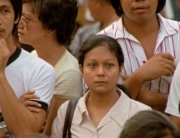In a bit more than an hour, How to Smell a Rose: A Visit with Ricky Leacock in Normandy provides a leisurely, insightful history of documentaries that parallels the filmmaker’s biography, done in the style he championed. It was made by Les Blank, who he greatly influenced. Adding poignancy to the informative conversations filmed in 2010 is that Leacock died the next year at almost 90 and Blank in 2013, age 78. His co-director Gina Leibrecht completed the editing.
Blank strolls around with Leacock at his farm, to the local markets, and as Leacock stands over his kitchen stove as he luxuriates in cooking with those acquired fresh ingredients next to his younger girlfriend and collaborator, Valerie Lalonde. The mostly chronological biographical questions are generously illustrated with family photographs and clips from his works. His first effort, at 14 years old, was a silent short centered on the work at his father’s banana plantation on the Canary Islands, after he returned from a British boarding school.
Driven from the Spanish territory by the civil war, he and his leftist family arrived in America on board the Normandie in 1938. At age 17, he proceeded to cross the country without any money. (He doesn’t mention here studying physics at Harvard, except that later he enjoyed dropping that factoid to impress those he was filming, like Leonard Bernstein.) During World War II, he served in an army film unit in Burma, and there are photos of him lugging a heavy Bell & Howell camera.
He fortuitously found his focus when he worked for several years as a cameraman for Robert J. Flaherty’s Louisiana Story (1947), and he talks fondly of how much he learned from “the father of documentaries” by patiently filming nature, and in natural light. Leacock was more interested in the technical aspects of Flaherty’s art than the usual attention these days to Flaherty’s blending of documentary and fiction. He details his admiration for how the director made an oil rig seem like a threatening character by filming it from certain angles and through a sequence that gradually reveals its full height—a wonderful cinematic teaching moment.
Leacock vents his frustrations from dragging around 100 pounds of equipment in the 1950s as he made short documentaries for early television programs (Omnibus), and for not being able to capture scenes as they happened with synchronous sound and pictures. In 1960, he, alongside Robert Drew, D.A. Pennebaker, the Maysles Brothers, and others, revolutionized the technology and process of nonfiction filmmaking, with handheld cameras for the “direct cinema” approach of filming up close and all around a subject, now more usually called “cinema vérité.” Their work at that time inspired Blank to start his career documenting American music and culture using their methods.
Leacock chortles on the making of their groundbreaking Primary in Wisconsin, about the run for the Democratic nomination between John F. Kennedy and Hubert H. Humphrey. Their team was right with JFK and Jackie in their suite as speeches and campaign tactics were being developed, while the press corps lined up outside the hotel waiting for formal comments. He analytically compares a scene from Robert Redford’s The Candidate (1972), which borrowed a scene of a staff meeting word-for-word, but he doesn’t mention how Primary also served the Kennedy campaign’s purpose of making its candidate look more informal and fresh than politicians from the past.
Clips from subsequent documentaries fill out anecdotes on his favorite subjects, some who became friends, such as Igor Stravinsky. Usefully, New York’s Film Forum is accompanying screenings with the 26-minute Happy Mother’s Day (1963). Presumably learning from the early media circus of the 1934 Dionne quintuplets in Ontario, Leacock, with Joyce Chopra, turn their cameras from the taciturn, overwhelmed Fischer family to reveal how the businesses of Aberdeen, South Dakota, and commercial photographers and magazines are posing and positioning the family for their purposes.
Thrilled at the new miniaturized and constantly changing technology, and easily adapting to computerized editing, Leacock delighted in carrying a camera everywhere, showing he could make a marvelous film just from the everyday life of his French village in Les Oeufs a la Coque de Richard Leacock (1991). He shared those combined interests through his 20 years teaching at Massachusetts Institute of Technology (1968–1989), and his influence can clearly be seen in such students’ personalized work as Ross McElwee’s Bright Leaves (2003).
Rose is not included in the 14 film Criterion Collection box set Les Blank: Always for Pleasure, but with these theatrical showings and festival screenings, on top of the posthumous releases of Blank’s A Poem Is a Naked Person and the last film by Leacock’s colleague Albert Maysles (In Transit), students of the documentary art form still have the opportunity to learn from these masters.
















Leave A Comment